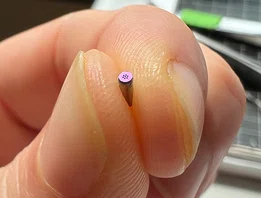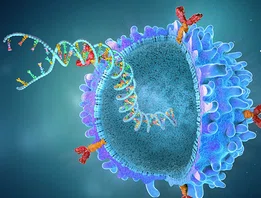


VIDEO
Video by Jose Hernandez
Due to their unique optoelectronic properties, the gamut of applications of gold nanoparticles is wide. Notably, they play a significant role in the diagnostics and therapeutics for human cancer.
Various innovative approaches are used to modify the optical and electronic properties of gold nanoparticles by optimizing the size, shape, surface chemistry, or aggregation state. Gold nanoparticle functions include drug delivery in biological and medical fields, photodynamic therapy, diagnostics, in addition to electronics, probes and sensors.
Carly Filgueira, PhD
Carly Filgueira, PhD, Assistant Professor of Nanomedicine, spearheads projects aimed at finding alternative treatment approaches to various diseases by leveraging nanotechnology. Conventional therapeutic interventions for cancer have several limitations such as poor drug delivery to the tumor where less than one percent of the treatment is utilized. Tumors are also heterogeneous, making it harder to treat them successfully. To offset these limitations, Filgueira and her team utilize targeted drug delivery, sustained release techniques and local delivery to specific sites using gold nanoparticles. Because of the optical properties of the gold nanoparticles, Filgueira can visualize where the therapy is mobilizing. Interestingly, by altering the surface functionalization of the gold nanoparticles Filgueira is also able to direct where the therapy is targeted within the tumor.
These approaches have great potential for the field of cancer medicine as well as treatments for other diseases where nanotechnology can be utilized. Benefits may include improved treatment outcomes, fewer side effects of therapy, improved quality of life for patients and a significant reduction of the healthcare economic burden.
For further information on Filgueira’s work on this topic, see the following papers:
Rossana Terracciano, Yareli Carcamo-Bahena, Amber Lee R Royal, Luca Messina, Jack Delk, E Brian Butler, Danilo Demarchi, Alessandro Grattoni, Zhihui Wang, Vittorio Cristini, Prashant Dogra, Carly S Filgueira. Zonal Intratumoral Delivery of Nanoparticles Guided by Surface Functionalization. Langmuir. 2022 Nov 15;38(45):13983-13994. doi: 10.1021/acs.langmuir.2c02319.
Nilesh Mathuria, Amber Lee R Royal, Julia Enterría-Rosales, Yareli Carcamo-Bahena, Rossana Terracciano, Amish Dave, Miguel Valderrabano, Carly S Filgueira. Near-infrared sensitive nanoparticle-mediated photothermal ablation of ventricular myocardium. Heart Rhythm. 2022 Sep;19(9):1550-1556. doi: 10.1016/j.hrthm.2022.05.006.
Rossana Terracciano, Yareli Carcamo-Bahena, E Brian Butler, Danilo Demarchi, Alessandro Grattoni, Carly S Filgueira. Hyaluronate-Thiol Passivation Enhances Gold Nanoparticle Peritumoral Distribution When Administered Intratumorally in Lung Cancer. Biomedicines. 2021 Oct 28;9(11):1561. doi: 10.3390/biomedicines9111561.
Dennis K Wang, Maham Rahimi, Carly S Filgueira. Nanotechnology applications for cardiovascular disease treatment: Current and future perspectives. Nanomedicine. 2021 Jun:34:102387. doi: 10.1016/j.nano.2021.102387.
Rossana Terracciano, Aobo Zhang, E Brian Butler, Danilo Demarchi, Jason H Hafner, Alessandro Grattoni, Carly S Filgueira. Effects of Surface Protein Adsorption on the Distribution and Retention of Intratumorally Administered Gold Nanoparticles. Pharmaceutics. 2021 Feb 5;13(2):216. doi: 10.3390/pharmaceutics13020216.
Abanti Chattopadhyay, PhD
February 2024
Related Articles







